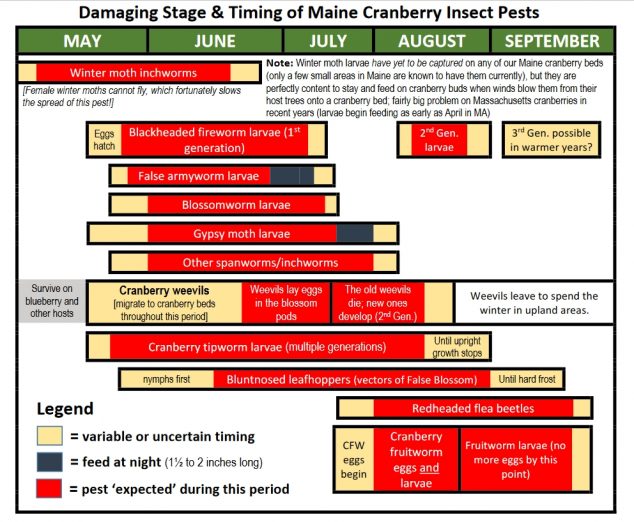Damaging Stage and Timing of Maine Cranberry Insect Pests (Calendar)
(All dates are approximate!)
text version equivalent:
Winter Moth:
- Winter moth inchworms [Female winter moths cannot fly, which fortunately slows the spread of this pest!]; Note: Winter moth larvae have yet to be captured on any of our Maine cranberry beds (only a few small areas in Maine are known to have them currently), but they are perfectly content to stay and feed on cranberry buds when winds blow them from their host trees onto a cranberry bed; fairly big problem on Massachusetts cranberries in recent years (larvae begin feeding as early as April in MA)
- Expected during: May 7th – June 17th
- Variable or uncertain timing: May 1st – June 24th
Other species of spanworms/inchworms:
- Expected during: June 1st – July 31st
- Variable or uncertain timing: May 20th – August 7th
False Armyworm:
- False armyworm larvae:
- Expected during: May 25th – June 25th during the day, and from June 26th – July 10th feeding mostly at night under cover of darkness
- Variable or uncertain timing: May 20th – July 15th
Blackheaded Fireworm:
- Blackheaded fireworm egg-hatch: variable timing; any time between approximately May 14th and May 21st
- Blackheaded fireworm larvae (1st generation):
- Expected during: May 21st – July 7th
- Variable or uncertain timing: May 14th – July 15th
- Blackheaded fireworm larvae (2nd generation):
- Expected during: August 10th – August 20th
- Variable or uncertain timing: August 5th – August 31st
- Expected during: August 10th – August 20th
- Blackheaded fireworm larvae (3rd generation): Believed to be possible in warmer years and more and more possible as the overall climate warms.
Blossomworm:
- Blossomworm larvae:
- Expected during: June 1st – July 10th
- Variable or uncertain timing: May 20th – July 17th
Spongy Moth:
- Spongy moth larvae:
- Expected during: June 1st – July 16th during the day, and from July 17th to July 31st feeding mostly at night
- Variable or uncertain timing: May 14th – August 7th
Cranberry Weevil:
- Adult weevils migrate to cranberry beds from about May 14th and continue doing so through as late as roughly June 20th (and feeding on cranberry buds and leaves)
- Weevils mate and deposit their eggs ‘into’ unopened flower pods from about June 20th through the duration of bloom
- Throughout the rest of July and first portion of August, the parent generation of weevils die and their offspring develop, forming a second generation of weevils.
- Starting anytime from early to mid-August, the new/offspring weevils leave cranberry in order to spend the winter in upland areas away from the beds.
Cranberry Tipworm:
- Cranberry tipworm larvae (multiple generations which quickly begin to overlap):
- Expected during: May 22nd – August 15th
- Variable or uncertain timing: May 14th – end of August (until upright growth shuts down)
- Expected during: May 22nd – August 15th
Bluntnosed Leafhopper (a known vector of cranberry false blossom disease):
- Expected during: June 15th – August 25th (a hard frost will finish them off)
- Variable or uncertain timing: May 22nd (nymphs) – middle of September or until a hard frost, whichever comes first
Redheaded Flea Beetle (adults):
- Expected during: August 1st – September 18th
- Variable or uncertain timing: July 14th – September 24th
Cranberry Fruitworm:
- Expected during:
- Eggs begin anywhere from mid-July to almost the end of July.
- Eggs and larvae both, from end of July to mid-August
- Larvae alone (no more eggs) from mid-August to September 24th
- Eggs begin anywhere from mid-July to almost the end of July.
- Variable or uncertain timing: Larvae may persist through almost the end of September depending on the season.

